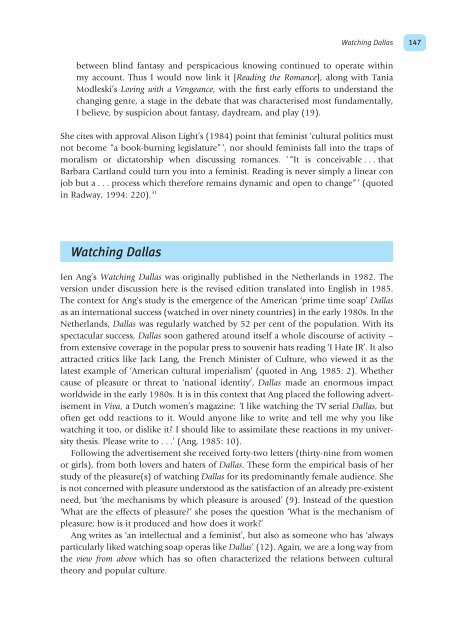Cultural Theory and Popular Culture
Cultural Theory and Popular Culture
Cultural Theory and Popular Culture
You also want an ePaper? Increase the reach of your titles
YUMPU automatically turns print PDFs into web optimized ePapers that Google loves.
etween blind fantasy <strong>and</strong> perspicacious knowing continued to operate within<br />
my account. Thus I would now link it [Reading the Romance], along with Tania<br />
Modleski’s Loving with a Vengeance, with the first early efforts to underst<strong>and</strong> the<br />
changing genre, a stage in the debate that was characterised most fundamentally,<br />
I believe, by suspicion about fantasy, daydream, <strong>and</strong> play (19).<br />
She cites with approval Alison Light’s (1984) point that feminist ‘cultural politics must<br />
not become “a book-burning legislature” ’, nor should feminists fall into the traps of<br />
moralism or dictatorship when discussing romances. ‘ “It is conceivable . . . that<br />
Barbara Cartl<strong>and</strong> could turn you into a feminist. Reading is never simply a linear con<br />
job but a . . . process which therefore remains dynamic <strong>and</strong> open to change” ’ (quoted<br />
in Radway, 1994: 220). 31<br />
Watching Dallas<br />
Watching Dallas 147<br />
Ien Ang’s Watching Dallas was originally published in the Netherl<strong>and</strong>s in 1982. The<br />
version under discussion here is the revised edition translated into English in 1985.<br />
The context for Ang’s study is the emergence of the American ‘prime time soap’ Dallas<br />
as an international success (watched in over ninety countries) in the early 1980s. In the<br />
Netherl<strong>and</strong>s, Dallas was regularly watched by 52 per cent of the population. With its<br />
spectacular success, Dallas soon gathered around itself a whole discourse of activity –<br />
from extensive coverage in the popular press to souvenir hats reading ‘I Hate JR’. It also<br />
attracted critics like Jack Lang, the French Minister of <strong>Culture</strong>, who viewed it as the<br />
latest example of ‘American cultural imperialism’ (quoted in Ang, 1985: 2). Whether<br />
cause of pleasure or threat to ‘national identity’, Dallas made an enormous impact<br />
worldwide in the early 1980s. It is in this context that Ang placed the following advertisement<br />
in Viva, a Dutch women’s magazine: ‘I like watching the TV serial Dallas, but<br />
often get odd reactions to it. Would anyone like to write <strong>and</strong> tell me why you like<br />
watching it too, or dislike it? I should like to assimilate these reactions in my university<br />
thesis. Please write to . . .’ (Ang, 1985: 10).<br />
Following the advertisement she received forty-two letters (thirty-nine from women<br />
or girls), from both lovers <strong>and</strong> haters of Dallas. These form the empirical basis of her<br />
study of the pleasure(s) of watching Dallas for its predominantly female audience. She<br />
is not concerned with pleasure understood as the satisfaction of an already pre-existent<br />
need, but ‘the mechanisms by which pleasure is aroused’ (9). Instead of the question<br />
‘What are the effects of pleasure?’ she poses the question ‘What is the mechanism of<br />
pleasure; how is it produced <strong>and</strong> how does it work?’<br />
Ang writes as ‘an intellectual <strong>and</strong> a feminist’, but also as someone who has ‘always<br />
particularly liked watching soap operas like Dallas’ (12). Again, we are a long way from<br />
the view from above which has so often characterized the relations between cultural<br />
theory <strong>and</strong> popular culture.
















